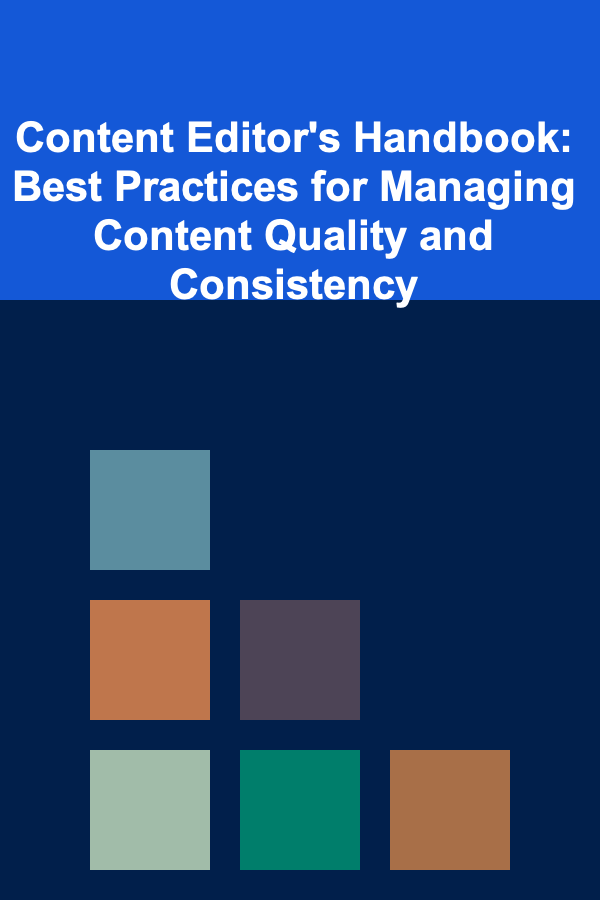
Content Editor's Handbook: Best Practices for Managing Content Quality and Consistency
ebook include PDF & Audio bundle (Micro Guide)
$12.99$5.99
Limited Time Offer! Order within the next:

Content editing is more than just fixing spelling and grammar mistakes---it's about shaping the message, ensuring clarity, maintaining consistency, and optimizing the content to resonate with the intended audience. As content creators, editors must develop a keen eye for detail and a comprehensive understanding of the material to refine it into its best possible version.
This actionable guide delves into the best practices for managing content quality and consistency, providing editors with the tools and techniques they need to produce polished, cohesive, and high-quality content.
Establish Clear Editorial Guidelines
Before diving into the specifics of editing content, it's essential to establish a set of editorial guidelines that serve as the foundation for all content creation and editing. These guidelines set the tone for consistency across different pieces of content, ensuring that everything produced adheres to a uniform standard.
Define the Brand Voice
Every piece of content should reflect the brand's personality. Is the tone casual and friendly, formal and authoritative, or something in between? Establishing a clear voice helps content maintain a consistent feel, even when it spans multiple authors or platforms.
- Example: For a tech blog, a casual, approachable tone might work best. However, for an academic paper, a formal and authoritative tone is necessary.
- Actionable Tip: Develop a style guide that includes examples of "what to do" and "what not to do" with regard to tone, word choice, and style.
Set Rules for Language Usage
Consistency in language usage is vital to ensure that the content is easy to understand and professional. Some areas to consider include:
- Grammar Rules: Define whether you will use Oxford commas, for instance, or whether contractions will be allowed.
- Word Choice: Set a standard for the terminology that will be used throughout your content. For example, should you use "website" or "site"? "Customer" or "client"?
- Spelling and Punctuation: Decide on American or British English spellings and punctuation rules to maintain uniformity across content.
Include Formatting Guidelines
Consistency extends to formatting. Whether it's for online articles, blog posts, or academic papers, formatting plays a significant role in readability and engagement.
- Headings and Subheadings: Establish a hierarchy for headings (e.g., H1 for titles, H2 for major sections, H3 for subsections).
- Font Usage: Define which fonts will be used for body text, headings, and captions. For digital content, it's often best to stick to web-friendly fonts.
- Bullet Points and Numbered Lists: Provide clear instructions on how to format lists for clarity and ease of reading.
Ensure Clarity and Conciseness
Great content is clear, concise, and easy to follow. One of the most critical aspects of editing is ensuring that every piece of writing is free of unnecessary complexity and wordiness. Readers are often looking for direct answers to their questions or easy-to-digest information, so it's essential to streamline content while maintaining its integrity.
Cut Unnecessary Words
Review the content for redundancies and eliminate any phrases that don't add value. Reducing wordiness enhances readability and ensures that the message is delivered more efficiently.
- Example: "In order to" can often be simplified to just "to."
- Actionable Tip: When editing, look for phrases or words that repeat the same idea. Replace them with more concise alternatives.
Avoid Jargon and Complex Terminology
Overuse of jargon or highly technical terms can alienate a broad audience. Even if the content is meant for professionals, try to explain complex ideas in a straightforward manner.
- Example: Instead of "optimize the process flow via automation," say "improve the process using automation."
- Actionable Tip: Where jargon is necessary, make sure to define or explain it briefly.
Prioritize the Main Message
Every sentence should contribute to the central theme or message of the content. If a sentence or paragraph doesn't directly support the main message, it should be cut or reworked to stay relevant.
Maintain Consistent Formatting and Style
Consistency is not just about language or tone---visual elements are equally important in ensuring a cohesive reading experience. Whether it's blog posts, website copy, or marketing materials, consistent formatting helps create a professional look that aligns with the brand.
Standardize Headings and Subheadings
The way headings are formatted should be standardized across all content types. This makes the content easier to scan, improves SEO, and ensures a more uniform experience for readers.
- Actionable Tip: Establish a consistent heading structure for all content. This helps in both SEO and user experience, making it easy for readers to find what they're looking for.
Use Consistent Visual Elements
Incorporate consistent visuals throughout your content. This includes images, infographics, videos, and other multimedia elements. These visuals should reflect the content's style, tone, and message while maintaining consistency in placement, size, and style.
- Example: If your company uses a specific color palette for graphics or infographics, be sure to stick to those colors to avoid inconsistency.
- Actionable Tip: Create a visual style guide that includes logo usage, color schemes, and the type of images to use, ensuring everything aligns with the brand's identity.
Ensure Consistency in Formatting Lists, Quotes, and Citations
When using lists, quotes, or citations, ensure that each follows a consistent format. This helps readers navigate the content easily and lends credibility to the piece.
- Example: If you use bullet points in one section, ensure they are formatted the same way throughout the document (same style, alignment, etc.).
- Actionable Tip: Use templates or style guides to ensure uniformity across different types of content.
Implement a Thorough Editing Process
A single round of editing is rarely enough to catch every issue. A structured, multi-step editing process is essential for producing high-quality content that is free of errors and inconsistencies.
Step 1: Content Review and Structure
Start by reviewing the content at a macro level. Does the content meet its intended purpose? Is the message clear, and is the content structured logically? This is also a good time to assess if the content adheres to the editorial guidelines.
- Actionable Tip: Create a checklist of key editorial points (tone, structure, key messages) to review during this step.
Step 2: Sentence-Level Editing
Once the content's structure is solid, move to sentence-level editing. Focus on improving clarity, grammar, and readability. Remove any ambiguity and ensure each sentence supports the overall argument or message.
- Actionable Tip: Read the content out loud to identify awkward phrasing, clunky sentences, or areas that may need rewording.
Step 3: Proofreading for Grammar, Spelling, and Punctuation
After the structural and sentence-level edits are done, it's time for a final proofread. Look for grammatical errors, spelling mistakes, punctuation issues, and typos. Even small errors can negatively impact the content's credibility.
- Actionable Tip: Use proofreading tools like Grammarly or Hemingway to catch overlooked mistakes, but always double-check manually for accuracy.
Step 4: Consistency Check
This is the final pass, where you'll ensure that the tone, formatting, and language are consistent throughout the entire piece. Compare the content to the editorial guidelines and check for any inconsistencies that may have slipped through earlier rounds.
- Actionable Tip: Take a step back and read the content with fresh eyes. Ask yourself: "Does this feel consistent with other pieces of content we've produced?"
Use Technology to Streamline the Process
While a manual editing process is crucial for quality control, there are several tools and technologies available that can help streamline and speed up the editing workflow. However, they should be used to complement your judgment, not replace it.
Grammar and Spelling Tools
Platforms like Grammarly, ProWritingAid, and Hemingway are excellent for catching basic grammar, spelling, and punctuation issues. They also help identify overly complex sentences, repetitive words, and readability concerns.
- Actionable Tip: Use these tools as the first step to clean up content. But always follow up with manual proofreading to ensure nuance and style are maintained.
Collaboration and Feedback Tools
For teams, collaboration tools like Google Docs, Trello, or Asana allow for smooth content review and approval workflows. These tools let multiple team members provide feedback and edit the document simultaneously.
- Actionable Tip: Utilize comment features in Google Docs to leave notes on specific sections, ensuring everyone on the team has input before the final version is published.
Version Control Systems
When multiple versions of content are created and edited over time, it's important to keep track of changes. Tools like GitHub or version control features in Google Docs help ensure you're working with the most up-to-date version and can roll back to previous drafts if necessary.
- Actionable Tip: Regularly save drafts and document significant edits to maintain a clear history of changes.
Continuous Improvement and Learning
Content editing is an evolving process, and the best editors are those who continuously seek to improve their craft. Stay updated with the latest trends in content creation, SEO best practices, and editing techniques.
Read Widely
Expose yourself to a variety of content types---articles, blogs, academic papers, etc. This broadens your understanding of different writing styles and structures, allowing you to adapt to various content needs.
- Actionable Tip: Subscribe to industry-related blogs or attend webinars on writing and editing to stay informed.
Gather Feedback
Seek feedback from colleagues, clients, or readers on the quality of your edited content. Constructive feedback is invaluable for identifying areas for improvement and refining your editing process.
- Actionable Tip: After publishing content, review performance metrics (e.g., engagement, readability scores) to understand which edits were most effective.
Conclusion
Managing content quality and consistency requires a deep commitment to detail, a structured approach to editing, and an understanding of both the content's goals and its audience. By following these best practices, content editors can ensure that every piece of writing not only communicates its intended message effectively but also aligns with the brand's voice and meets high standards of readability and clarity. With continual improvement and the right tools, content editing becomes an invaluable skill that drives engagement, trust, and authority in any industry.
Reading More From Our Other Websites
- [Home Renovating 101] How to Replace a Bathtub for a Modern and Functional Upgrade
- [Home Budget 101] How to Plan a Monthly Grocery Budget and Stick to It
- [Home Party Planning 101] How to Plan a Rustic Farmhouse-Style Dinner Party
- [Home Rental Property 101] How to Create a Rental Lease Agreement That Protects Both Parties
- [Home Family Activity 101] How to Host an Unforgettable Family Talent Show: Tips for Planning and Execution
- [Home Party Planning 101] How to Host a Holiday Party That Guests Will Remember
- [Soap Making Tip 101] Mastering Swirls: Step-by-Step Recipes for Gorgeous Layered Soaps
- [Organization Tip 101] How to Use the KonMari Method for Workspace Decluttering
- [Personal Care Tips 101] How to Choose a Conditioner That Is Safe for Children's Hair
- [Organization Tip 101] What Are the Best Ways to Organize Your Home Office Supplies?

How to Create a Mindful Morning Routine for Better Focus
Read More
How to Make Money Online as a Voice User Interface (VUI) Designer: 10 Actionable Ideas
Read More
How to Save Big on Home and Car Insurance: Expert Advice
Read More
How to Sell Digital Planners for Students: An Actionable Guide
Read More
How to Use Vertical Space to Save Room in Your Home
Read More
10 Tips for Work Planning with ADHD
Read MoreOther Products

How to Create a Mindful Morning Routine for Better Focus
Read More
How to Make Money Online as a Voice User Interface (VUI) Designer: 10 Actionable Ideas
Read More
How to Save Big on Home and Car Insurance: Expert Advice
Read More
How to Sell Digital Planners for Students: An Actionable Guide
Read More
How to Use Vertical Space to Save Room in Your Home
Read More